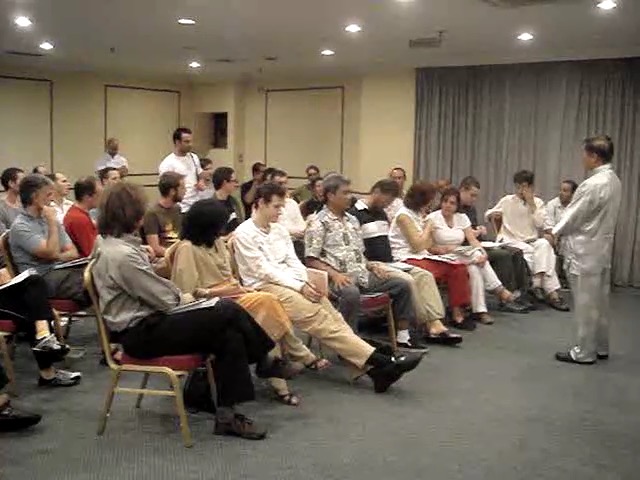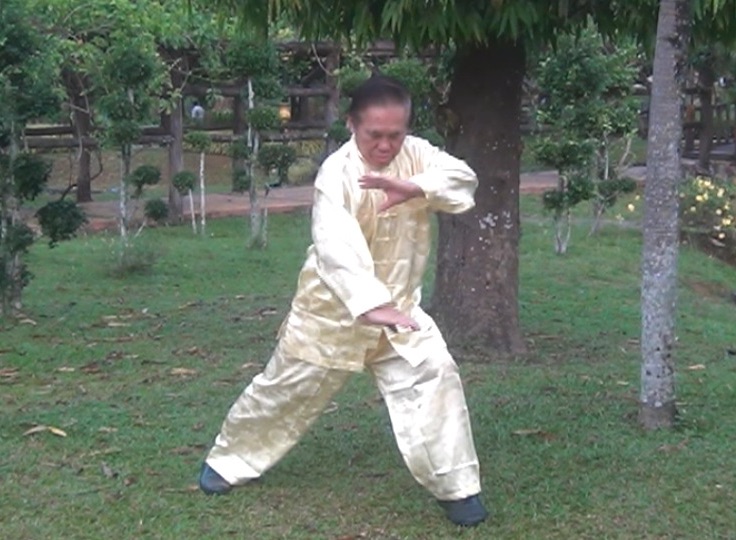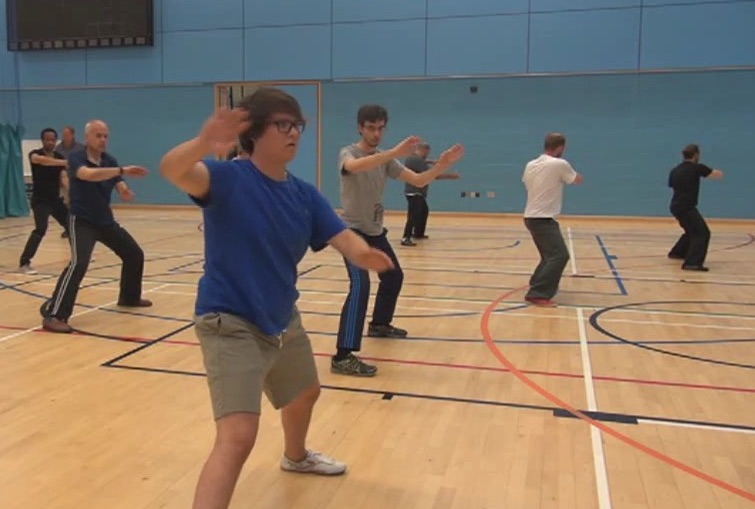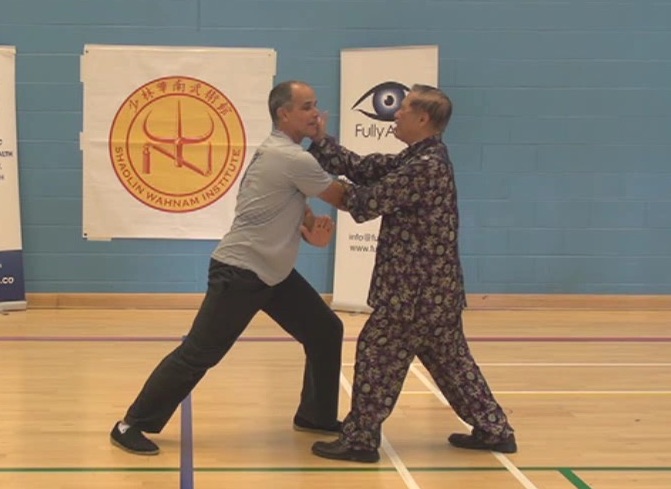SELECTION OF QUESTIONS AND ANSWERS
JULY 2020 PART 1

Chi Kung Healing Course in 2019
Question 1
I hope you and your family are well. I have been enjoying your recent Question and Answer posts, particularly regarding bone marrow cleansing and past lives.
— Berg, USA
Answer
My family and I are doing very well. At present my wife, myself, my youngest daughter, her husband and their son are enjoying ourselves traveling before my courses at the Holistic Health Cultivation Centre in Kuala Lumpur honorarily organized by Dr Foong.
(This question was asked before the Chi Kung Healing Course and the Special Lion Dance Course in 2019. You can view the two courses here and here.)
My Question-Answer Series are very popular, though now I focus more on answering questions from our family members. Of course I still answer questions form the public. Questions from our family members are more specific, whereas questions from the public are more general. General questions are found in the early years of our Question-Answer Series.
Bone Marrow Cleansing is an advanced art. Depending on where we let energy to flow, we can cleanse past life emotions, enhance vitality and longevity, and build a lot of internal force.
Question 2
I have been working through a deep blockage that has been bringing up a lot of unpleasant emotions (anger, fear) that seems tied to some traumatic childhood experiences and possibly past lives.
I practice basic chi kung exercises like "Lifting the Sky" a few times a month. Anything more seems to cause over-cleansing and the emotions become too difficult to manage.
Answer
Cleansing unpleasant emotions that seem tied to some traumatic experiences in past lives can be well done with Bone Marrow Cleansing, especially at the organ level, and lastly at the bone marrow level. But you can cleanse the negative emotions using Five-Animal Plan and 18 Lohan Hands.
Practicing "Lifting the Sky" a few times a month is insufficient. You need to practice chi kung everyday, just about 10 minutes a session, 2 sessions a day. Just doing that -- i.e. practicing chi kung 10 minutes a session, twice a day -- will clear your negative emotions, overcome any illness, and give you good health, vitality and longevity. It will also make you lucky.
Bone Marrow Cleansing at the organ level, and at the bone marrow level if needed, is excellent in cleansing deep rooted emotional problems. If it is fear that troubles you, you can cleanse your kidneys; if it is anxiety, you can cleanse your stomach; and if it is sadness, you can cleanse your lungs. If you are not sure what the negative emotions are, you can perform Bone Marrow Cleansing at different levels.
If the negative emotions are deep rooted, like caused by past lives, it is excellent to cleanse them using Bone Marrow Cleansing. If they are at the surface or recently caused, they can be cleansed using Five-Animal Play or 18 Lohan Hands.
The depth of mind and skills in practice are important in cleansing as well as in building. If the negative emotions are caused by past lives, or if a person wants to build a lot of internal force for marital arts or scholarly studies, he should go deep in the depth of mind, and apply high-level skills. If the negative emotions are recently caused or if he wants some internal force and mental clarity for daily living, he can be relatively shallow in his mind focus and apply low-level skills.
Irrespective of whether he is elementary or advanced, he should guard against over-training. Our arts are very powerful; it is easy to over-train. Over-training occurs when ones physical body cannot take the rapid increase of results.
Of course, the over-training differs between an elementary practitioner and an advanced practitioner. What is over-training for an elementary practitioner may be insufficient for an advanced practitioner.
Over-training also differs in time for the same person. What is over-training when he first begins practicing chi kung may be just right for him after two years of daily training.
Of course, the depth of mind and the level of skills are different between an elementary practitioner and an advanced practitioner. An advanced practitioner can regulate his depth of mind and level of skills, but a beginner can't.
Most practitioners in other schools practice gentle physical exercise though they use chi kung techniques. Practicing gentle physical exercise no matter for how long cannot overcome illness.
For an advanced practitioner like you, using a simpler exercise like "Lifting the Sky" can cleanse at the organ level like Bone Marrow Cleansing if you enter the mind level and apply skills appropriately. You can start with lower level of mind and skills, and gradually increase them.

"Bong Sau" or Guard-Hand in Southern Shaolin
Question 3
After reading your answers regarding past lives and Bone Marrow Cleansing I wanted to ask your advice on what the best steps to fully resolving this blockage would be.
Is it possible that a deeper exercise like Bone Marrow Cleansing would be required to fully release the block? Or would continuing with simple exercises like "Lifting the Sky" and Five-Animal Play be the best approach?
What about the depth of mind and skill in practice? Can going deep on the mind level with a simpler exercise like "Lifting the Sky" accompanied by chi flow still cleanse at the organ and at the marrow levels?
Answer
If you are overwhelmed by emotions, you probably practice at a mind level and a skill level too high for cleansing. Remember that our low levels are very high for other practitioners. Other practitioner do not even know how to enter into a chi kung state of mind and have the skills to generate an energy flow.
Masters -- real ones, not those we call out of politeness -- can enter into a chi kung state of mind and generate an energy flow unknowingly after many years of daily practice. But those who attended my intensive courses can do so on the very first day of the course.
Question 4
I'm now living in Bangkok, and married a beautiful Thai girl last year. So despite the cleansing my luck has been very good lately. Since I am so close to some of our school's top healers (your son, Dr. Foong), do you think it would be any benefit to seeking out healing sessions? Or would this just lead to more over cleansing?
Answer
Congratulations for marrying a beautiful Thai girl. You must love her dearly.
You must be lucky, simply because you practice genuine chi kung. I am sure you know that to be lucky is "hou yun qi" in Chinese, which literally means "good circulation of energy".
Taking our Chi Kung Healing Course is excellent, especially for those who wish to know more about chi kung healing and who want to become chi kung healers. Taking the course would not lead to more cleansing. Over cleansing is the result of over-training. In practice, it is due to training at a mind level and a skill level too high for your physical body for a prolonged period of time.
I train at only about 30% of my potential, and my practice has given me good health, vitality, longevity, peak performance and spiritual joys every day.

Developing internal force in Wudang Kungfu
Question 5
I was wondering was the "bong sau" in Wing Choon any different in usage, philosophy and application than the "bong sau" in Southern Shaolin (Hoong Ka)?
— Mohammed, UK
Answer
"Bong sau", or guard-hand, in Wing Choon is similar to "bong sau" in Southern Shaolin (Hoong Ka). "Bong sau" is more often used in Wing Choon than in Southern Shaolin. In Southern Shaolin, "phiet sau", or "sweeping hand", is used instead. "Phiet sau" is also found in Wing Choon.
Many people use "phiet sau" as a block. It should be used as a sweep, breaking the opponent's elbow or wrist when he extends his arm. It is actually a secret, and we share secrets generously.
"Bong sau" is used to avoid a low punch, while guarding the hand. The philosophy is in rotating the waist. Certainly it is not blocking with the arm. Its application is mainly against a low punch, but sometimes the opponent may use a claw or a different hand form. It can be used against a kick, but "phiet sau" is generally used -- in both Wing Choon and Southern Shaolin.
Question 6
Also, I have noticed that the pattern called "Taan Sau" in Wing Choon looks very similar visually to the naked eye to the pattern called "Beauty Looks at Mirror" in Hoong Ka. Again is there any big difference in application or philosophy between the "taan sau" pattern and the "Beauty looks at Mirror" pattern?
Answer
"Taan Sau" or "tan sau" is similar to "Beauty Looks at Mirrow" or "mirrow hand" in Southern Shaolin (Hoong Ka). It is more often used in Wing Choon Kungfu.
When I was training with Uncle Righteousness and Sifu Ho Fatt Nam, I used "tan sau", or students called it "mirrow hand", often especially against a straight punch at the middle level. Now I changed it to "Single Tiger Emerges from Cave" or single tiger-claw, which is generally used in Shaolin Wahnam. Mirrow hand is mainly used for defence, but single tiger-claw can be used for attack. Of course, for a skillful practitioner mirrow hand or "tan sau" can also be used for attack.
I was very interested in the history of Wing Choon Kungfu. It is actually a branch of Shaolin Kungfu, and early Wing Choon masters like Wong Wah Poh, Leong Yi Tai and Leong Chan used many Shaolin stances like the Bow-Arrow Stance and the False-Leg Stance.
The founder of Wing Choon Kungfu, Yim Wing Choon, found the Shaolin stances too wide, so she narrowed them when she daily practiced her kungfu. Instead of the Horse-Riding Stance she used the Goat Stance; instead of the Bow-Arrow Stance she used the Four-Six Stance. But she still maintained the Shaolin stances.
For example, in "seong phiet sau", or double hand sweeps, we use the Horse-Riding Stance, and in "tip cheong", or butterfly palms, we use the Bow-Arrow Stance. (You can find "seong phiet sau" at Pattern 53 of the 72-Pattern Tiger-Crane Set, and "tip cheong" at Pattern 19 of Chiam Kiew. Both are Wing Choon sets in our school.) It should also be mentioned that the Goat Stance and the Four-Six Stance were not Yim Wing Choon's inventions; they were already found in Shaolin Kungfu.
Yim Wing Choon generally started her kungfu practice with Siu Lin Tou. In Choe Family Wing Choon promoted by Patriarch Choe Hoong Choy, Siu Lin Tou included the three sets of Siu Lin Tou, Cham Kiew and Phew Chew. In Hong Kong Wing Choon, which is the most popular type of Wing Choon Kungfu today, the three sets are practiced separately, and they are Siu Lim Tou, Cham Kiew and Phew Chee.

Grandmaster Wong uses "Gentle Breeze through Sleeves" to counter Sifu Angel's attack
Question 7
I want to write an essay on Wudang Kungfu so I might, one day, be considered as a Guardian of the Method. Would you be so kind as to provide suggestions or a rough guideline that I could follow as what would be an appropriate title and what kind of information must be included.
— Sifu Angel Perez, Shaolin Wahnam Puerto Rico
Answer
You will be a right person to write on Wudang Kungfu, and hope that you will be the Protector of Wudang Kungfu and help to spread it.
An appropriate title is "History, Practice and Benefits of Wudang Kungfu". A brief outline for the treatise is as follows:
- History of Wudang Kungfu.
- Taoism and Wudang Kungfu.
- What has been done in the practice and spread of Wudang Kungfu.
- The special features of Wudang Kungfu.
- The benefits of Wudang Kungfu.
Wudang Kungfu is based on Taoism. Nevertheless, those who practice Wudang Kungfu may not be Taoists. Taoism is actually not a religion as many Westerners categorize it.
There are many people who practice Wudang Kungfu. The most widely practiced kungfu is Shaolin Kungfu, but most people practice gymnastics. They do not know how to use their kungfu, any style of kungfu, for combat, and they do not have internal force. Combat efficiency, internal force and spiritual cultivation are the hall marks of genuine Wudang Kungfu and genuine Shaolin Kungfu.
A special feature of Wudang Kungfu is its softness. Its softness is very powerful. It can be used to enrich our daily life. A common force of Wudang Kungfu is Cotton Palm, but most people do not know Cotton Palm.
Wudang Kungfu, especially its modern form of Taijiquan, has enriched my kungfu very much.
There are many benefits of Wudang Kungfu. It provides good health, vitality, longevity, peak performance and spiritual joys.
Question 8
Can you be so kind as to make suggestions as what would be the best training program for me according to my aspirations on becoming the best Wudang Kungfu student and practitioner, please?
Answer
Suggestion for a training program for Wudang Kungfu is to ensure your getting the benefits of your training. You should have combat efficiency, good health, vitality, longevity peak performance and spiritual joys. At the risk of antagonizing other people, which is actually their problem and not ours, many people do not get the benefits of their training.
The hallmarks of Wudang Kungfu are combat efficiency, internal force and spiritual cultivation. You will have no difficulty in combat efficiency as you were an international sparring champion, but you can improve using Wudang techniques on genuine masters and professional fighters.
Internal force will not only enhance our combat efficiency but also increase our health, vitality, longevity and peak performance. You will, for example, accomplish more in three hours with better results than other people in five.
For us, spiritual cultivation means we are happy every day, irrespective of whether we are alone in a desert island or busy in city life.
In practical terms, it means spending about half an hour to an hour of daily practice on the following: set practice to be familiarized with Wudang kungfu techniques; combat application to apply Wudang techniques on your opponents; and force development to develop internal force.
In the Wudang course where you were my sparring partner, we applied "Gentle Breeze through Sleeves" against all forms of attack. You may like to improve on your skills, especially your force and speed. As soon as a master or a professional fighter moves, he finds himself defeated. You can also start the attack.
Question 9
I am training the Wudang Kungfu set on Tuesdays and Fridays and the Wudang Sword on Wednesdays and Saturdays. After each session I practice Stance training on the Three Circles for only 5 minutes as the energy flow from training the Set and Sword is quite strong. Spending more than 5 minutes has proven to be over-training for me, and I end up feeling quite heavy instead of light, and dull instead of vibrant.
Answer
The Wudang Kungfu set, which we call "San Feng Wudang Set" in honour of Zhang San Feng was an excellent set incorporating force training and combat application, the two hallmarks of any kungfu training. It is a set for advanced practitioners, and not suitable for beginners.
The Wudang Sword is lovely. Not only it can improve our agility and combat efficiency, it can also improve many aspects of our daily life.
Over-training is a major issue in our school. We must guard against it. Nevertheless, you may gradually increase your time of force training.
Our kungfu will enhance every aspect of our daily life -- in ways we may sometimes not realize. You are doing very well in Wudang Kungfu, but if there are any techniques which you like me to elaborate, please let me know.
I don't have any plan to teach a Wudang course in the future, but if there are many people interested, I may consider it.
LINKS
Selected Reading
- Chi Flow and Cash Flow
- Evolution of Shaolin Kungfu to Taijiquan
- Some Real Feeling about Chi (Qi)
- Taijiquan Cloud Hands in Slow Motion
- Majestic Temples
